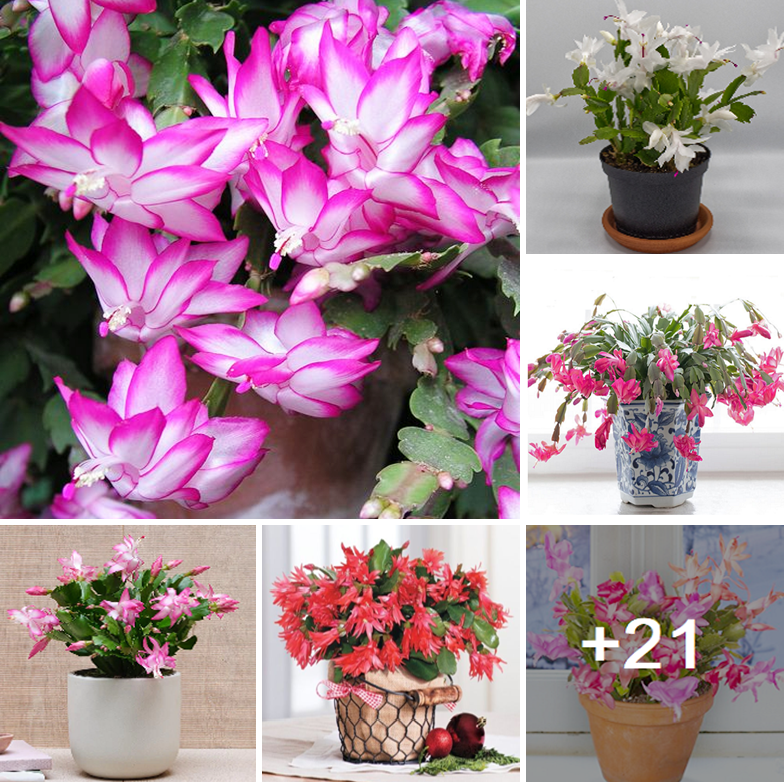
Thanksgiving cactus (Schlumbergera truncata): The leaves distinguish this cactus from the Christmas cactus. Also known as the Crab Claw Cactus (for its pointy thorns), these plants have flowers that come in a range of mostly pastel colors, from red and pink to peach and purple. And according to the Farmer’s Almanac, Thanksgiving cactus anthers are yellow, while Christmas cactus anthers are pink to purple-brown.
Easter cactus (Hatiora gaertneri): Easter cacti bloom in spring. The Farmer’s Almanac describes them as having “leaves with small bristles and a thick ridge on one side.” Unlike the other holiday types, they have star-shaped flowers and are native to the non-tropical forests of Brazil.
How to care for a Christmas cactus
Lack of water and dramatic temperature swings can cause flower buds to drop faster. Maximize your specimen’s flowering period by paying attention to these six key factors:
Soil: Use a quality soil rich in humus and other nutrients.
Temperature: Maintain an optimal climate of 65 degrees.
Watering: Keep the soil evenly moist while your plant is blooming, misting it often.
Light: Place the cactus in an east-facing window for moderate light and some direct sun.
Fertilization: Apply a high potassium fertilizer every two weeks as buds form.
Transplantation: Replant your cactus every year after flowering.
how to care for the Christmas cactus plant
While Christmas cacti are typically low-maintenance plants, they are not immune to pests and diseases. If you find your plant has been invaded by pests, Gardening Know How shares ways to avoid some of the most common types.
Mealybugs: These insects commonly infect indoor plants. They have cottony masses that make them easy to spot and can attract mold if left alone over time. Pick them off with a toothpick or use a systemic insecticide formula to get rid of them.
Spider mites: Although you may not be able to spot these tiny insects on your cactus, their webbing on the leaves makes their presence known. These dust-like creatures can be removed with insecticidal soap spray.
Fungus gnats: These insects are not only small, they also fly and love moist soil. You may notice a loss of leaves if the infestation is heavy. If insecticidal soap sprays don’t work, fill a clean pot with fresh, well-drained potting mix before replanting.
How to encourage more flowering
Keep the plants cool (about 50 degrees) after the flowering period. Water them to keep the soil barely moist, and be sure to keep fertilizer in. When new growth begins, use the following strategy to encourage flowering: Place the plants in an environment with a temperature between 55 and 65 degrees, alternating between giving them 10 hours of light and 14 hours of total darkness for four to six weeks after growth appears . When buds appear, introduce the plant to warmer temperatures and begin regular cultivation, as described above. Plants should flower in about six weeks.
How to Repot a Christmas Cactus
Your festive vegetables only need to be replanted every three to four years. Notice if the roots are starting to grow out of the bottom of the container or if its overall appearance looks tired.
Choose the right container. Choose a pot that is slightly larger than your older one. Make sure it has a drainage hole in the bottom, as your Christmas cactus will rot if it lacks air.
Make sure your potting mix is light and well drained. Never use soil that comes straight from your garden, says Plant Care Today, because it can contain bacteria and viruses that can harm your plant.
Replant your Christmas cactus. After carefully removing your plant, massage the roots to remove old soil, then place it in the new container so that “the top of the root ball is about an inch (2.5 cm.) below the rim of the pot,” according to Knowledge of gardening.
Water your plant moderately and place it in a shady spot for two to three days, as an excessive amount of direct sunlight can damage the leaves.





















